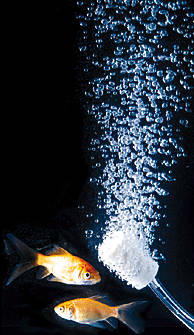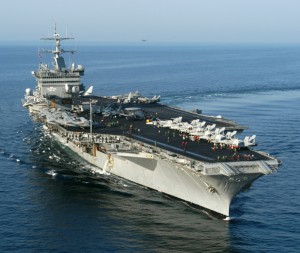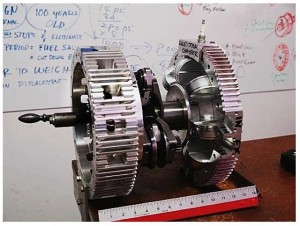The real Planet Earth has an ongoing situation that could use a ship of superheros like those in Gene Roddenberry’s Star Trek soap opera.
60+ days have passed since the Deepwater Horizon’s explosion and sinking. BP company engineers have been working continuously to stop the oil, but all efforts to plug the gusher in the gulf have failed. Efforts to contain the oil are ongoing, but the best case scenario calls for the well to run until the relief wells are completed in August.
In short, people are becoming aware that BP’s Big Problem in the Gulf of Mexico is probably the most epic environmental catastrophe of the past 1000 years.
If only the Enterprise was available to help.
While I admire the engineers working to stop the gusher for their methodical and careful approach, I am not impressed with any of the existing efforts to remediate the uncontained environmental damage.
Cleaning up the untold millions of gallons of oil already leaked is a decidedly comedic affair. They play the TV-watching public for fools, as if cleaning a beach at this point in time will help. Furthermore, there are reports from the front lines that some cleanup crews arrive for the TV cameras or government overseer and leave as soon as they’re not needed to maintain BP’s facade.
All “feel good” efforts to clean the beaches in the Gulf of Mexico should be stopped immediately. Not only are they pointless, they put human lives in decidedly unhealthy conditions.
I’ve corralled Irvin Lipp, who drives me and a few wire photographers out to Elmer’s. (He tells me ruefully that he has history with Mother Jones, having once been a flack for Dupont.) The shoreline is packed with men in hats and gumboots and bright blue or white shirts. Nearly all are African-American, all hired from around New Orleans. They tell me they’ve been standing in these exact same spots for three days. It’s breathtakingly hot. They rake the oil and sand into big piles; other workers collect the piles into big plastic bags, and still other workers take them to a plant where the sand is separated out and sent to a hazardous-waste dump and the oil goes on for processing. Then the tide comes in with more oil and everybody starts all over again. Ten dollars an hour. Twelve hours a day. When I joke with one worker that he should pocket the solid gobs of oil he’s digging up to show me how far beneath the sand they go, he stops dead and asks me if BP’s still trying to use the oil they all collect. “Aw, I knew it!” he says. Another leans on his rake to ask me, “Have they at least shut the oil off yet?” He randomly picks three spots in a three-foot-wide expanse of sand that he’s already raked clean and drops his rake in an inch deeper to show me how the oil bubbles up from underneath. He can’t count how many times he’s raked this same spot in the 33 hours he’s worked it since Thursday, but one thing he’s sure of, he says, is that he’ll be standing right here tomorrow and the next day, too.
–It’s BP’s oil (emphasis added)
Maybe someone can help me understand why BP hires people to remove tarballs when there’s another supertanker’s worth of oil coming inbound? And what’s the point of sending fishing dinghies to corral floating crude oil? Somebody should have a talk with them about scale.
Rolling Stone Magazine has a good analysis of how the disaster developed:
BP is the last oil company on Earth that Salazar and MMS should have allowed to regulate itself. The firm is implicated in each of the worst oil disasters in American history, dating back to the Exxon Valdez in 1989. At the time, BP directed the industry consortium that bungled the cleanup response to Valdez during the fateful early hours of the spill, when the worst of the damage occurred. Vital equipment was buried under snow, no cleanup ship was standing by and no containment barge was available to collect skimmed oil. Exxon, quickly recognizing what still seems to elude the Obama administration, quickly shunted BP aside and took control of the spill.
…
The company applied the same deadly cost-cutting mentality to its oil rig in the Gulf. BP, it is important to note, is less an oil company than a bank that finances oil exploration; unlike ExxonMobil, which owns most of the equipment it uses to drill, BP contracts out almost everything. That includes the Deepwater Horizon rig that it leased from a firm called Transocean. BP shaved $500,000 off its overhead by deploying a blowout preventer without a remote-control trigger – a fail-safe measure required in many countries but not mandated by MMS, thanks to intense industry lobbying. It opted to use cheap, single-walled piping for the well, and installed only six of the 21 cement spacers recommended by its contractor, Halliburton – decisions that significantly increased the risk of a severe explosion. It also skimped on critical testing that could have shown whether explosive gas was getting into the system as it was being cemented, and began removing mud that protected the well before it was sealed with cement plugs.
–The Spill, The Scandal and the President (emphasis added)
But pointing fingers doesn’t help anyone. It’s more productive to be solution-oriented than looking to cast blame.
Mother Nature has the most effective oil-remediation strategy of all. Oil-eating bacteria regularly consume crude oil that seeps into the gulf every day.
But the volcano is releasing more oil than the bacteria can handle. These bacteria need oxygen to process the oil, but the volcano’s hydrocarbons readily bind with oxygen that’s already present in the water.
Save the Gulf With Oxygen
Anyone who has a fish tank knows that the water must be aerated to keep oxygen levels high enough for a tank full of fish to survive. This is accomplished with the humble airstone. When coupled with an air pump, surface area of water in direct contact with air increases dramatically, thereby speeding up the process of replacing Carbon Dioxide with Oxygen.
In nature, fish live in oceans, lakes, ponds, and rivers. These bodies of water all have large surface areas and sometimes large currents as well. This serves to oxygenate the water so that fish survival is possible. However, in an aquarium, the surface of the water is greatly reduced. Therefore, artificial ways of oxygenating he water must be accomplished through aeration. There are several ways to aerate your aquarium and these methods will be discussed in this article.
The amount, rate and spatial concentration of crude oil released from such an event overwhelm the natural mechanisms of oil dispersal and breakdown, producing the significant ecological effects that we observe.
–Natural Oil Seeps and the Deepwater Horizon Disaster: A Comparison of Magnitudes
Oil doesn’t consume oxygen especially quickly, but natural gas does. BP’s gusher is much more than crude oil – millions of cubic feet of gasses are also being released. These gasses rapidly consume all available oxygen.
“how serious is the oxygen depletion problem?” … “Very Serious” … “How much biodegredation appears to being observed for the oil plumes?” … “There is a tremendous amount of oxygen consumption in the plumes. We have measured respiration rates in the plumes, above and below the plumes, and at control sites where plumes are not present. The respiration rates in the plume are at least 5-10 times higher than we see anywhere else.”
Turn the cleanup operation over to the United States Navy
The BP executives’ primary responsibility is to their shareholders scattered across the world. The U.S. Navy’s shareholders are the people who live in the United States. One concise proponent of the Navy’s involvement made this case:
The navy has a huge workforce (#7), Wed Jun 02, 2010 at 10:32:39 AM EST
… And boats, and loads of equipment of all kinds. The military is, in general, experts at getting in place ad hoc infrastructure, which often includes containing various problematic elements like oil spills. It’s the only place to go if you need lots of manpower on short notice, and they have some expertise even though they’re not experts on oil spills per se.
Furthermore, the Navy doesn’t care about costs, whereas BP only spends enough to keep their little kingdom intact.
The Navy knows all about operating fleets of gigantic ships. BP knows something about drilling holes in the ground. Leave BP in charge of the relief well, turn cleanup operations over to the United States Navy, and send BP the bill.
There are many strategies for cleaning up spilled oil. Skimmers are being used, and manufacturing for Kevin Costner’s new oil/water separating centrifuge has begun. These efforts should continue. Crude oil-containing water can be pumped into supertankers and separated on land, as was done in Saudi Arabia years ago.
But the most important remediation effort hasn’t been used anywhere yet. Win Wenger has an old proposal for using underwater bubble fences to farm fish. The bubble fences keep the fishies corralled in their pens, and also encourage the growth of phytoplankton for the fish to feed on. Massive air pumps can and should be deployed to introduce large amounts of oxygen to the plumes of undersea oil.
The only problem left to help facilitate Mother Nature’s oil cleanup is powering the banks of air pumps that will be needed. Even though there are new pumps that are better than existing designs, it will still take a tremendous amount of energy to pump air 200-5,000+ feet below the surface.
“Several people have asked whether there is a way to introduce oxygen into the deepwater to correct any significant oxygen deficit. We don’t know yet whether that will be necessary because we don’t know whether oxygen will reach stressful low levels (<2 mg/L). However, it could be fairly difficult to do aerate the water at the depths (1100m) we are seeing oxygen depletion. So I’m not sure that is a solution to deepwater oxygen problems.”
So much for that idea?
To Save The Gulf, Send the Enterprise
This is where the USN Enterprise comes in. Enterprise is the Navy’s first nuclear-powered aircraft carrier. It was just retrofitted, and the crew is currently preparing the ship for deployment. The U.S. Navy has plans to send the Enterprise on two six-month cruises before decommissioning it in 2013.
With 6 reactors generating 310 Megawatts of thermal power, Enterprise is the world’s largest floating nuclear powerplant. No other ship or generating system anywhere has the power needed to oxygenate the oil plumes in the Gulf of Mexico.
Building a Better Pump
While there are already pumps that would probably be capable of getting a flow of bubbles down to 1000 meters, all existing types of gas compressors are barely acceptable for the task. Fortunately there is a new engineering-complete pump design that, with a few tweeks by engineers familiar with salt water environments, would be extremely valuable for gulf cleanup operations. Whether the Navy decides to pump air or water, Raphial Morgado’s new Mighty Pump (MYT, for Massive Yet Tiny) will be a valuable tool. Morgado says that his pump is the only existing design that offers pressure, volume and flow in a single package.
After licensing the design, the U.S. Navy’s engineers can refine the pump for their purposes and the military-industrial complex can quickly establish a production line. The Mighty pump only has 22 parts, so manufacturers will be able to get these new pumps into production quickly.
Converting Steam to Compressed Air
A neat feature of the MYT design is that two pumps can be used back-to-back. One pump is attached to the Enterprise’s steam catapult lines and turns pressure into rotational motion. The other pump is attached to the rotating drive shaft and generates compressed air to pump underwater or to drive other MYT pumps at distant locations.
The Enterprise Can Stop Hurricanes
Concerns have been spreading online that a tropical storm may carry the oil inland, which could make the situation in the gulf exponentially worse. There is an as-yet untested method for reducing tropical storm intensity that uses the same air pumps as in the proposal outlined above:
Nearly all the energy which drives a tropical disturbance comes from warm surface water. Eliminate the warm surface water in the immediate path–or in the breeding grounds–of a hurricane, and you eliminate the hurricane.
A low-cost, low-energy way to eliminate the warm surface water, where it would otherwise soon be feeding a hurricane or other tropical disturbance, is to cause the water to “turn over.” This is done by pumping compressed air down toward gulf or sea bottom and releasing it. The cooler waters come to the top and the hurricane loses its energy over them to become disorganized squalls.
Where are such cooler bottom waters available? Virtually everywhere. Even the bottom of the Gulf of Mexico is littered with blobs of ice. Ices of (natural) gas hydrate and methane ice (melting point 45 degrees F) occur to such an extent that some have been investigating how to extract that methane ice as a fuel resource (The Washington Post, August 11, 1997, p. A3). And the Gulf is one of the warmest open bodies of water on the planet (and one of the most frequent spawners of tropical disturbances).
–Hurricane Stopper Invention: Proposed system for stopping hurricanes, typhoons, and tropical storms
Time to Correct Course
BP is doing everything it can to plug their well and save their company, but everything isn’t enough. The U.S. Navy needs to immediately be put on task to organize and deploy resources in the gulf, including skimmers, supertankers, centrifuges, and bubble fences.
Portable nuclear reactors are the best way to power this massive infrastructure, and the U.S. Navy has the only portable nuclear power stations available.
Tell everyone you know: send the Enterprise, for it truly is our only hope.
(update: a followup to this article has been posted: When Disaster Strikes, Send the Enterprise)



Leave a Reply